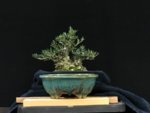Sifu,[ Adair ]
through the aid of the Japanese Embassy, we were put in touch with
the Nippon Bonsai society in 1987.
So yes, we have had the ears and eyes of both Japanese and Chinese
masters.
But I do remember telling you this a while ago.
By the way don't you learn by rote as well ?
Good Day
Slow student.
Anthony
* just in case you didn't realise, new natives requires experimentation
and Design requires new ideas.
So we don't learn by rote.
Remember the J.b.pine in the West Indies, has no teacher.
Just lots of suggestions and then experimentation.
Anthony, learning by rote, is memorization, like learning the multiplication tables.
Learning to wire is learning a diagram, then learning how to apply that diagram to the branch structure you are working on. After a while, with sufficient practice, you don’t have to “think” about it, it comes “naturally”. Your eye sees the pattern, your hand have the muscle memory to apply the wire correctly and efficiently. The same way, every time.
The next few paragraphs are NOT about bonsai, lol!!!
In my youth, I played tennis. I was good enough to play at the collegiate level. I practiced, practiced, practiced. So that when I was in a match, I didn’t think about, “see the ball, turn, run to where the ball is going to be, get your racket back, shift your weight as you hit, follow thru, move back to the center of the court...”. No, that stuff became automatic. Instead, I could concentrate on stuff like, “move him to the far side of the court, he’s likely to return cross court, next shot, hit down the line, rush net, be ready to volley for winner...”
In other words, once I had solid mechanics, I could concentrate on strategy. At that level, the game changes from who has the better mechanics to a mental battle. Who wants to win more. How to recognize your opponents weaknesses and how to best take advantage of them.
I’ll give you an example: one guy I played had a very strong forehand. His back hand wasn’t weak, but it wasn’t nearly as powerful as his forehand. He could blast shots by you with that forehand.
So, I knew I couldn’t trade shots with him. My strategy became this: I hit every ball to his backhand side. He ran me all over the court with backhand shots both down the line and crosscourt. I kept him pinned in his backhand corner. Points lasted a long time, with many long rallys. He started becoming frustrated, occasionally running around his backhand in order to hit a forehand. This opened up the court so I could hit a winner into to open court! So, he gave up on that, and resigned himself to a backhand battle. So, then I could do this: after hitting about 15 to 20 shots to his backhand, I would hit one wide to his forehand! He would be so happy to get a chance to hit a forehand, he’d over hit! Sending it out!
I beat him 6-2, 6-2. In a match that took 2 hours. Usually, that lopsided a score would be done in about 45 minutes! But I was playing a chess match. He was a “stronger” player than I was. I couldn’t out hit him. But I won. Dominated, actually.
Not once did I think about the mechanics of what I was doing. Body memory, yes. By rote? I don’t think so.
Back to bonsai.
Yes, the Japanese Masters want their apprentices to get so good at the menial tasks they don’t have to think about them. Just do them. This frees the brain to think about design, style, movement, character, future development, etc.



